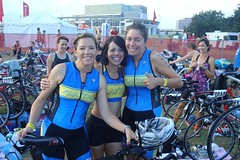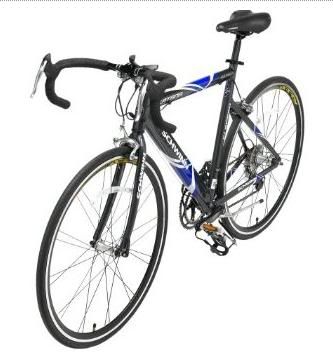As we continue through the 2nd decade of the 21st century, some Schwinn enthusiast may have decided to achieve a greater advanced level of endurance by participating in a triathlon. A triathlon is a multi-sport endurance event consisting of swimming, cycling, and running in immediate succession over various distances. Triathletes compete for the fastest overall course completion time, including timed transitions between the individual swim, bike, and run components.
According to the International Triathlon Union and the USA Triathlon, the main international race distances are Sprint distance (750 m swim, 20 km bike, 5 km run), Intermediate distance, commonly referred to as Olympic distance (1.5 km swim, 40 km ride, 10 km run), Long Course (1.9 km swim, 90 km ride, 21.1 km run), such as the Half Ironman, and Ultra Distance (3.8 km swim, 180 km ride, and a marathon: 42.2 km run); the most popular branded Ultra Distance is the Ironman triathlon.
The Schwinn Katana Road Bike is reccommended for entrance level competition.
Find Schwinn Katana Road Bike on eBay
The demanding nature of this sport focuses primarily on persistent and often periodized training in each of the three events, as well as combination workouts and general strength conditioning to ensure the highest levels of endurance and power possible on race day. Proficiency in swimming, cycling, and running alone is often not sufficient enough for success in the triathlon.
As many prepare to swim, cycle and run in a triathlon, there are a few things to keep in mind while getting in shape. As with any physical activity, preparing for a triathlon is a process. Before starting a vigorous endurance program you should have a base level of fitness and consult your doctor or physical trainer prior to beginning a training program. Most triathletes will begin a training program for approximately 16 weeks to prepare for an Olympic distance triathlon.
Training Tips
- Train with a heart rate monitor to stay in the target zone.
- Practice your glycogen and fluid-replacement strategies in training so you can safely rely on them in important events and race situations.
- Practice transitions and plan out the process of moving from one event to the next to save every second possible and achieve the quickest time.
It is also important for athletes to maintain proper nutrition and hydration while training for such a big event. Regular stretching routines and constant sleep patterns will gear up the body for optimum performance. In addition to physical preparation, joining a club or working with a coach will help with mental readiness.
Biking-specific training tips
Before you get on your bike for a training ride, evaluate your riding fit and form. This is important for minimizing discomfort, preventing injuries and improving performance. Since individuals come in all shapes and sizes, a perfect fit to a standardized bicycle can be difficult. Bicycles come in varying sizes with multiple interchangeable and adjustable parts. The most common injuries from biking are attributed to improper bike fit or form and include muscle or tendon strain, nerve compression and joint ailments. Often these aches and pains are in the knees, back, neck, wrists and hands. Various bicycle frame sizes and shapes make finding the right sized bike difficult.
Most bicycle shops and some manufacturers provide sizing charts based on height, weight or inseam length. An important factor to consider is not just the seat tube (bar determining seat height) length, but also the top tube (bar running between seat tube and handlebars). Generally, the most rear part of your body should be just inside of the rear hub (middle of the wheel) and your wrists should be just inside of the front hub.
Proper posture is also important. The general rule of thumb for a road bike position is a 25 to 30° angle at the knee, a 30 to 40° slope to the back and a 90 to 100° angle at the shoulder, between the body and upper arm.
As with most modes of exercise, appropriate warm-up and cool-down is critical to maximize performance and prevent injury. Warm-up should include starting out the ride at an easy, comfortable pace for about 5 to 10 minutes before working up to a workout pace. Following the ride, your muscles and tendons are most compliant and responsive to stretching. The muscles used most during cycling, therefore the most important to stretch, include the quadriceps (front of thigh), hamstrings (back of thigh), glutei (buttock) and calf muscles.
A Quick Review of Schwinn Katana Road Bike
Great entrance level bike for a triathlon! Made by Shchwinn, the giant in the industry of bike manufacturing, you can tell from the first look that the Schwinn Katana Road Bike is a great pick. Its light alloy frame gives this bike it’s sturdy look and comes in a choice of 54cm and 58cm frame. And the quality matches the first impression. The bike looks really gorgeous with its blue and black finish.
This bike is light. Combine that with what they call aerodynamic design, going fast is a breeze. Another good thing about this bike is control. Even though this is a fast bike, you will find that keeping control of your direction is still yours, and is very easy to maintain.
If you’re looking for an inexpensive entrance level road bike, look no further. The Schwinn Katana Road Bike is the perfect choice for triathlons and those who commute on a regular basis.
Find Schwinn Katana Road Bike on eBay
Running-specific training tips
In addition to proper training up to the event, it is important to consider tapering right before the event. Rest from running is recommended for one or two days prior to the big event, especially for beginners. For those with more experience, a light run of one or two miles for one or two days before the event is advisable.
Appropriate warm up is very important. This can include light jogging or track field drills such as high knees, leg kick backs, carioca and striding exercises. Mainly, concentrate on performing slow and controlled movements throughout and slightly in excess of the movement that will take place during the event. This will prepare your body for the event at your normal pace.
Swimming-specific training tips
Just as you adjust the gears on your bike and warm up your muscles before a run, swimming also requires plenty of preparation. Most common swimming injuries are due to compression of the tendons between the bones within the shoulder joint and tendinitis.
Methods to prevent those injuries in swimmers include modifying technique, training and improving flexibility and strength. Exercises should include those that help the rotator cuff and scapular stabilizer along with back and abdominal muscles or core body strengthening.



No comments:
Post a Comment